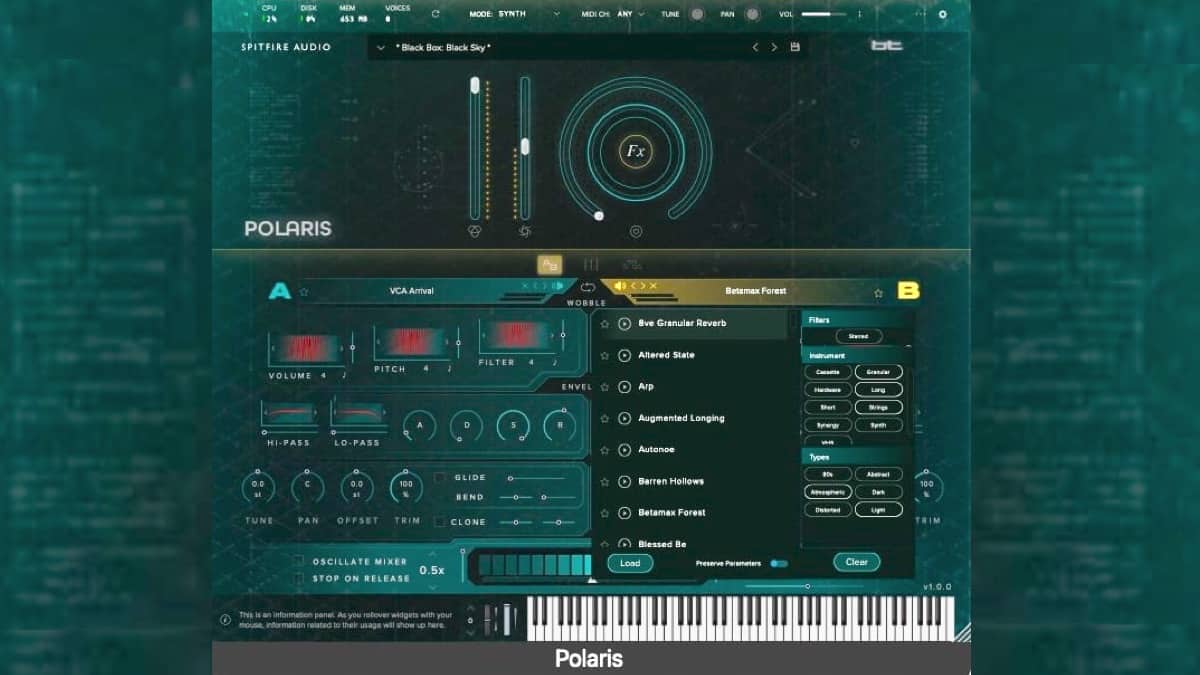In This Issue
Spitfire Polaris: the Synth and Software Review

The man bites dog story of a string orchestra emulating synthesizers…
Spitfire Audio is as widely known for its superbly detailed orchestral libraries as it is for producing more adventurous mashups of synthesis and sampling.
One of its more intriguing collections was Phobos, the byproduct of Spitfire’s collaboration with Brian Transeau (aka BT), a self-contained library of samples guided by synthesis and imaginative impulse modeling.
As with Phobos, Polaris teams resources with BT and Spitfire’s expert programmers. The concept, however, is somewhat the opposite, and a bit simpler to grasp.
It’s fairly commonplace for synthesizers to emulate orchestral instruments. Polaris turns that concept on its ear: replicating synthesizer sounds sourcing orchestral instruments.
This is not a completely novel approach, but Spitfire’s sound design smarts coupled with a powerful subtractive and granular synthesis engine bring it to the head of the class. To that end, the library comprises samples captured on a number of hardware samplers, which are then processed through the sampler’s synth architecture and additional DSP.
What is most successful about this tactic is that it retains an organic, animated quality beyond the capabilities of oscillators, LFOs, envelope generators, and other synthesis processes. Nonetheless, the instrument’s onboard synthesizer and DSP controls let you tailor the patches to your needs.
The interface is not all that different from Spitfire’s other sample-based synthesizers. if you own Spitfire Orbis, Earth, or other Spitfire titles, you should be comfortable navigating Polaris’ terrain.
The UI is decorated with faintly illuminated, animated widgets and scrolling lines of miniscule text that are strictly for eye appeal (but that I found distracting). Believe me, Polaris sounds good enough to eat, and has no need of eye candy. I’d urge Spitfire to consider enlarging the text to prevent eyestrain and headache.
À la mode. Phobos offers two distinctly different modes of operation: Synth, the default mode when first launched; and Standard.

Synth mode harbors its sample oscillators in “Bays,” which represent two independent signal paths, each with its own high- and lowpass filters, with ADSR envelopes for amplitude.

Although there is no ADSR for the filters, Phobos can automate filters on the fly via the large virtual knob to the right of the Expression and Crossfader sliders.
Editing filters is gratifyingly intuitive. Dragging vertically within a filter’s rectangle adjusts cutoff frequency, and horizontal moves alter resonance.
Expression and Crossfader sliders are mapped respectively to CC 11 (Expression) and 1 (Modulation) by default, but you can reassign these to any MIDI controllers you prefer.
In most cases the effect on the sounds is subtle. Part of this is due to the crafty pairing of sounds that are often similar, but in some cases articulated differently, allowing timbres to evolve and merge.
For example, in the patch Black Box: Bottom of the Pops, one source emerges slowly at a lower pitch, and glides ever so slowly into unison with the other, and eventually out of tune again -perfectly queasy underscoring for a scary flick.
Animation tools abound. Wobble bestows periodic LFO control over filter, pitch, or volume. A little goes a long way here, especially with regard to pitch.

More interesting is the Oscillate Mixer. This is basically automated crossfading between the two Bays via LFOs with a variety of shapes, along with a slider that can move continuously between LFO waveform shapes. It’s like having an auxiliary real-time envelope.
Noodling with a custom patch. The Oscillate Mixer smoothly crossfades between a rich orchestral sound and a sparkly, animated patch with lots of harmonic motion
High standards. Standard mode confers a different batch of sound design tools, including expansive layering options and creative round-robin techniques. It is no less a synthesizer than when in Synth mode.
In Polaris’ Standard mode. I start with a single “technique” – an orchestral patch. Next, a layer comprising the original, layered with processed, granular patch. and the orchestral patch with downward-sweeping pitch, followed by two granular-delay variations.
From the start, you get up to eight “Techniques,” which are oscillators loaded with orchestral sounds, both natural and processed. You can stack these, swap them out for other sounds, reorder them to your heart’s content.

One of Polaris’s strong suits is its Grain Delay. Experimentation yielded intriguing soundscapes, dissonant chords, and one-finger string ensembles, and lurching, aleatoric-sounding passages.

There’s much more to Spitfire Polaris than one can write in a review. At its simplest, it’s a tremendous wellspring of cinematic pads and backdrops. It’s also a pocket universe of rich sound design, with plenty of room to add your own stamp. I recommend it highly.
Price: $349















